A | B | C | D | E | F| G | I | L | M | N | P | R | S | T | U | W
Aerator
An aerator is a machine that removes short plugs of soil from the ground, increasing porosity and stimulating root growth.
Biolog
A biolog is a coir fiber log used to create a mini-terrace.
Concrete Slab Jacking
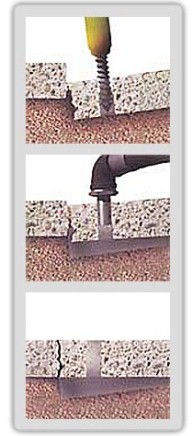 Slab jacking is a method of restoring sunken concrete slabs to their original grade. Slab jacking and sidewalk grinding are two alternatives to replacing sunken or uneven concrete. Slab jacking raises or stabilizes faulty concrete pavement in driveways, concrete stairs, and sidewalks and other slab-on-grade surfaces
Slab jacking is a method of restoring sunken concrete slabs to their original grade. Slab jacking and sidewalk grinding are two alternatives to replacing sunken or uneven concrete. Slab jacking raises or stabilizes faulty concrete pavement in driveways, concrete stairs, and sidewalks and other slab-on-grade surfaces
A cement slurry is pumped under the concrete to fill the void. This process lifts the sunken and uneven surface back into its proper position. It can also eliminate costly and irritating water problems by filling hidden cavities under the concrete and diverting water away from the foundation. Click on image to enlarge.
Development Under Bond
If a subdivision is "under bond," the stormwater infrastructure and other utilities are still under the responsibility of the developer - including their maintenance. The infrastructure is secured through a development agreement and security (the bond) held by Fairfax County. Once the bond is returned to the developer, they are no longer responsible for maintenance.
In a new development under bond, the builder may be responsible for fixing problems, including drainage and erosion issues. If problems on your property are occurring because of runoff from neighboring properties under bond, the builder of those properties may be responsible for repairs on your property. If this applies to you, consider calling the Fairfax County Site Development and Inspection Division at 703-324-1720, TTY 711. In other jurisdictions, contact the division responsible for inspection of new development under bond (often within the Public Works department).
Drip Line
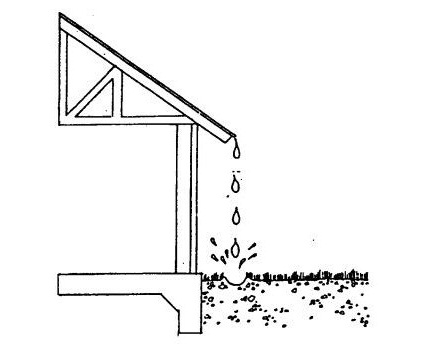 A drip line is the land directly beneath a source of falling water. The ground under the edge of the roof or gutter is referred to as the drip line, which is the most frequent usage in this guide.
A drip line is the land directly beneath a source of falling water. The ground under the edge of the roof or gutter is referred to as the drip line, which is the most frequent usage in this guide.
The term is also applied to trees, as in the area under a tree that receives water dripped from the trees branches and foliage.
Easement
An easement can be broadly defined as legal permission from an owner to allow others to access a portion of their property. Usually easements are granted in perpetuity, meaning that they continue to allow access even when the land is sold to another owner. There are a few different types of easements.
If a major utility line, such as a water main or stormwater pipe, cuts through private property, the county or utility company will have an easement that allows them the right to access or use those pipes, and that restricts how the easement area can be used by the homeowner. In addition to major utility lines which occur in easements, there are also private connections to main lines that you may need to watch out for.
A conservation easement is another type of easement that protects environmentally sensitive land or historical properties, often held by a conservation trust. In our area, the Northern Virginia Conservation Trust is one such organization. A Resource Protection Area also restricts the way homeowners can use land within an RPA, but it does not grant others the right to access your property.
Do you have an easement on your property? The plat of your lot will show any easements. Copies of plats are usually included in residential loan closing documents. If you do not have a copy, one can be obtained from the Zoning Permit Review Branch at 703-222-1082, TTY 711. Not all plats are available from the County. If the County does not have a copy of your plat, contact the lending institution from which your mortgage was obtained. The Conservation District can also help you determine if you have an easement on your property.
Fill Soil
Fill soil can be used to fill in depressions found near the foundation of a home or to fill in sinkholes. Fill soil should have high clay content and not too much sand. Simple tests can be used to determine the general content of the soil. Very gritty soil that barely forms a ball when moist is very sandy. Smooth or sticky soil that easily forms a wet ball has a better percentage of clay. Fill soil can be found for free on internet sites such as Craig's List and at construction sites.
Grade
 A grade is also known as a slope or incline. Throughout this guide, we recommend that the ground around your house should slope away from foundation walls. Ideally, at least a 5% grade should be maintained for a distance of ten feet around your home. A 5% grade means that the slope changes five feet in height for every 100 feet of horizontal distance. Over ten feet of horizontal distance from your foundation wall, there should be at least a 0.5 foot (six-inch) change in height. With regards to the grade around a home, a positive grade refers to ground that slopes away from the house, which is desirable to avoid erosion or a wet basement. A negative grade tilts toward the house, which is an undesirable condition.
A grade is also known as a slope or incline. Throughout this guide, we recommend that the ground around your house should slope away from foundation walls. Ideally, at least a 5% grade should be maintained for a distance of ten feet around your home. A 5% grade means that the slope changes five feet in height for every 100 feet of horizontal distance. Over ten feet of horizontal distance from your foundation wall, there should be at least a 0.5 foot (six-inch) change in height. With regards to the grade around a home, a positive grade refers to ground that slopes away from the house, which is desirable to avoid erosion or a wet basement. A negative grade tilts toward the house, which is an undesirable condition.
Groundwater
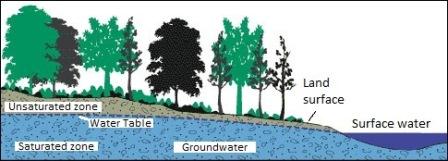 Groundwater is water below ground, filling up pore spaces in soil and joints in rocks. The water table is the depth to the surface of the saturation zone, the area of soil and rock that is saturated with groundwater.
Groundwater is water below ground, filling up pore spaces in soil and joints in rocks. The water table is the depth to the surface of the saturation zone, the area of soil and rock that is saturated with groundwater.
Groundwater that is naturally close to the surface can cause wet conditions. High groundwater is generally found in low lying parts of the landscape, especially in floodplains next to perennial streams. Water seepage can also be found on slopes from natural springs. Groundwater is generally closest to the surface in colder months, but wetness can occur throughout the year. Click on image to enlarge.
Gully and Gully Erosion
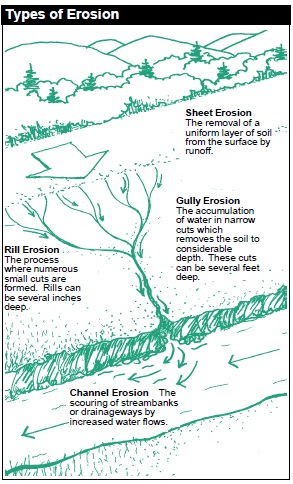 A gully is an incision or ditch created by the flow of running water. In the process of gully erosion, running water picks up soil or sediment in its path and moves it downstream, often depositing it into streams, lakes and rivers. Click on image to enlarge. Compare with Sheet Erosion.
A gully is an incision or ditch created by the flow of running water. In the process of gully erosion, running water picks up soil or sediment in its path and moves it downstream, often depositing it into streams, lakes and rivers. Click on image to enlarge. Compare with Sheet Erosion.
Infiltration
Infiltration is the rate at which water passes through soil, generally measured in inches per hour. Soils with high clay content or compact soils have slower infiltration while loose or sandy soils have a higher infiltration.
It is important to conduct an infiltration test prior to installing a rain garden or dry well. If your soil has poor infiltration at the bottom of the rain garden, you will likely need an underdrain. You can use the following steps to assist you in conducting an infiltration test.
How to Conduct an Infiltration Test:
- Dig a 12-inch (or deeper) hole at the proposed site of your rain garden or dry well and fill it completely with water.
- Allow the water to sit for at least an hour so that the soil can saturate.
- Refill the hole so it is full.
- From this point on, observe to see if the water drains into the soil.
- If the water drains within 48 hours, the site is suitable for a rain garden or dry well; however, it is highly recommended that the soil be amended with some compost and sand.
- If the water does not drain in 48 hours, select a different location or amend or replace the soil and install an underdrain. It may be easier to choose another location.
- You may choose to run the infiltration test more than once in the same hole or in different holes to ensure an accurate result.
See also: Permeability.
Landscape Fabric
Also called filter fabric or geotextile fabric. Landscape fabric is now typically made of synthetic (plastic) woven material. It is used to cover bare soil to prevent erosion. The tightness of the weave varies. In situations where water should not pass through the fabric, the weave should be tight. Looser weaves should be used when water is intended to pass through the fabric. Natural (non-synthetic) landscape material is a biodegradable option that can be used as an erosion control blanket until plant roots take hold.
Miss Utility
 Miss Utility, also known as Virginia Utility Protection Service (VUPS), is a free service that provides markings for underground utilities, including power, sewer, gas, water and cable lines. Miss Utility can be contacted by dialing 811 (in Virginia) or 1-800-552-7001.
Miss Utility, also known as Virginia Utility Protection Service (VUPS), is a free service that provides markings for underground utilities, including power, sewer, gas, water and cable lines. Miss Utility can be contacted by dialing 811 (in Virginia) or 1-800-552-7001.
Native Plants
 A native plant is a plant found in the ecosystem in which it has evolved. It exists in equilibrium with other species in the same ecosystem. In the United States, plants found in the country prior to European colonization are considered native. People everywhere are discovering the beauty and benefits of native plants, from canopy trees to shrubs to meadow species and native groundcover. They help restore the ecosystem as more land is cleared for buildings or roads. They can require less maintenance than other plants. They also provide food and shelter for people and wildlife.
A native plant is a plant found in the ecosystem in which it has evolved. It exists in equilibrium with other species in the same ecosystem. In the United States, plants found in the country prior to European colonization are considered native. People everywhere are discovering the beauty and benefits of native plants, from canopy trees to shrubs to meadow species and native groundcover. They help restore the ecosystem as more land is cleared for buildings or roads. They can require less maintenance than other plants. They also provide food and shelter for people and wildlife.
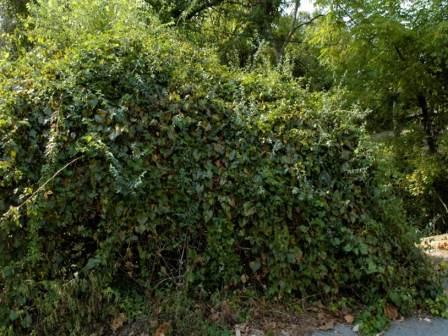 Invasive plants are aggressive non-native plants. These plants grow out of control when taken out of their native ecosystem. Kudzu or "the plant that ate the South" is an invasive that is commonly known. Invasive plants frequently escape from yards. Examples include English Ivy, Bamboo, Japanese Honeysuckle, and Garlic Mustard. For a full list of invasive plants that are problematic in Fairfax County, as well as how you can help, see Invasive Management Areas.
Invasive plants are aggressive non-native plants. These plants grow out of control when taken out of their native ecosystem. Kudzu or "the plant that ate the South" is an invasive that is commonly known. Invasive plants frequently escape from yards. Examples include English Ivy, Bamboo, Japanese Honeysuckle, and Garlic Mustard. For a full list of invasive plants that are problematic in Fairfax County, as well as how you can help, see Invasive Management Areas.
Permeability
The rate at which water passes through soil. Soils with high clay content or compact soils have slower permeability while loose or sandy soils have a higher permeability. See also: Infiltration.
Plat
A map showing the boundaries and key features of a property. Similar to a plan or blueprint of a house or interior space, a plat of a lot shows the characteristics of the exterior space.
Probe
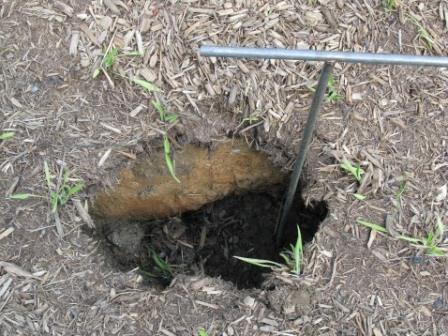 A soil probe is a long metal rod with a handle. It is particularly useful for determining the depth, size and extent of a sinkhole. If a probe is not available, a piece of rebar, shovel, fireplace poker or other implement can be used.
A soil probe is a long metal rod with a handle. It is particularly useful for determining the depth, size and extent of a sinkhole. If a probe is not available, a piece of rebar, shovel, fireplace poker or other implement can be used.
Resource Protection Area
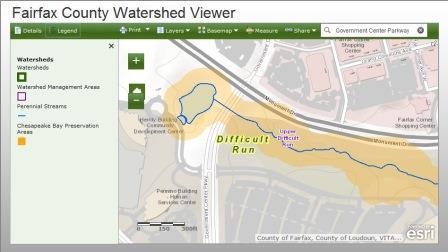 Perennial streams, coastline, wetlands, or other water bodies, and a buffer area (usually 100 feet) are protected as Resource Protection Areas, also known as Chesapeake Bay Preservation Areas. Soil disturbance, land clearing or development within an RPA is highly restricted and contingent upon permission from the County.
Perennial streams, coastline, wetlands, or other water bodies, and a buffer area (usually 100 feet) are protected as Resource Protection Areas, also known as Chesapeake Bay Preservation Areas. Soil disturbance, land clearing or development within an RPA is highly restricted and contingent upon permission from the County.
To determine if your property is in an RPA, use the Fairfax County Watershed Viewer. Enter your address to find your watershed, nearest stream and Resource Protection Areas. You can also contact the Conservation District (703-324-1460, TTY 711). District staff can help explain your options if your land is in an RPA.
Riprap
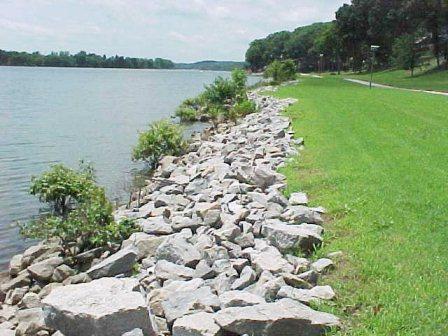 Riprap consists of large rocks used to reduce water velocity at the outfall of pipes or to reduce erosion by flowing water on soil surfaces or in stream beds.
Riprap consists of large rocks used to reduce water velocity at the outfall of pipes or to reduce erosion by flowing water on soil surfaces or in stream beds.
Runoff
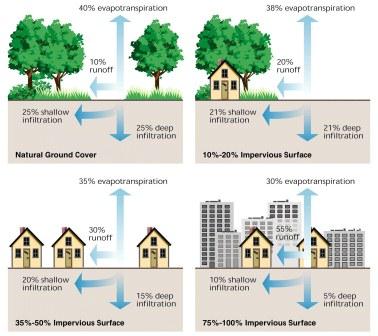 Runoff is the flow of water over land that does not infiltrate into the soil or evaporate into the atmosphere. Runoff can come from rain, melting snow or even hoses or sprinklers. Problems with runoff are exacerbated by impervious surfaces that prevent infiltration such as roofs, roads and driveways. Click on image to enlarge.
Runoff is the flow of water over land that does not infiltrate into the soil or evaporate into the atmosphere. Runoff can come from rain, melting snow or even hoses or sprinklers. Problems with runoff are exacerbated by impervious surfaces that prevent infiltration such as roofs, roads and driveways. Click on image to enlarge.
Sheet Erosion
 The removal of a uniform layer of soil from the surface by water runoff. Click on image to enlarge. Compare with Gully Erosion.
The removal of a uniform layer of soil from the surface by water runoff. Click on image to enlarge. Compare with Gully Erosion.
Soil Test
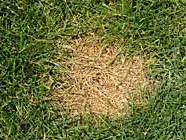 A soil test is the best way to determine if your soil needs a pH or nutrient change. A soil test kit can be obtained from Fairfax County libraries or the Soil and Water Conservation District office. You can mail your soil sample to Virginia Tech and receive a detailed report for a small fee of $10.
A soil test is the best way to determine if your soil needs a pH or nutrient change. A soil test kit can be obtained from Fairfax County libraries or the Soil and Water Conservation District office. You can mail your soil sample to Virginia Tech and receive a detailed report for a small fee of $10.
Tips for reading your soil test report and applying fertilizer or lime:
- A soil test can help you avoid fertilizer burn, when too much fertilizer kills grass or other vegetation.
- Adequate quantities of nutrients may be present in the soil, but if the soil pH is too acidic, nutrients may not available for plant use.
- Fertilizer recommendation is in pounds/acre (lbs./ac) and should be added once every year.
- Lime recommendation (for pH) is in tons/acre and should be added only once in three years.
- After a period of three years, a new soil test should be performed.
After correcting the pH or nutrient level, re-seed or replant the appropriate vegetation of your choice.
Splash Block or Splash Guard
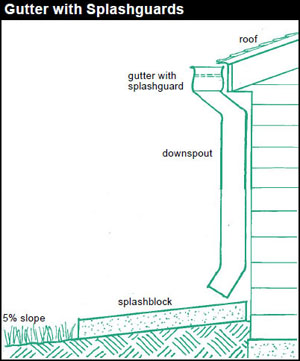 A plastic or cement plate placed at the end of a downspout to disperse and slightly slow down runoff and protect the underlying soil. Click on image to enlarge.
A plastic or cement plate placed at the end of a downspout to disperse and slightly slow down runoff and protect the underlying soil. Click on image to enlarge.
Suitable Outlet or Area
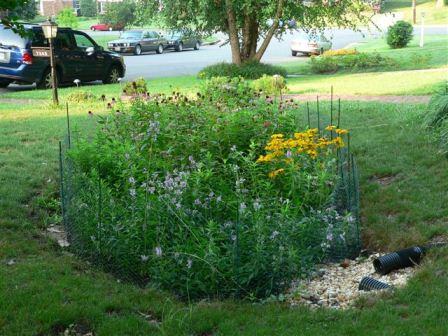 A suitable outlet is an area of land that is capable of receiving redirected runoff without causing erosion or sogginess. Examples include rain gardens, dry wells, existing swales or gently sloping vegetated land not immediately leading to neighboring properties. Ideally, runoff should be directed to an area where it can soak into the soil, filtering and cleaning the water.
A suitable outlet is an area of land that is capable of receiving redirected runoff without causing erosion or sogginess. Examples include rain gardens, dry wells, existing swales or gently sloping vegetated land not immediately leading to neighboring properties. Ideally, runoff should be directed to an area where it can soak into the soil, filtering and cleaning the water.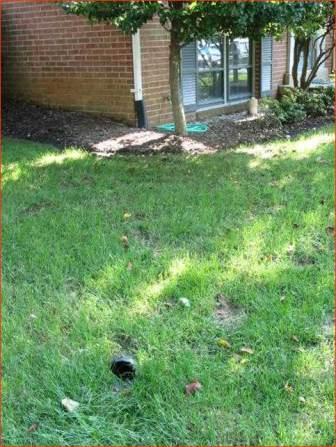
It is best to avoid connecting one impervious surface to another when discharging runoff. For example, from a water quality perspective, it is not preferable to discharge your roof runoff directly onto your driveway, flowing onto the street, into a storm drain and to the nearest stream, where the sheer volume of water flow can cause damage.
Conversely, an unsuitable or inadequate outlet is an area of land that is not capable of receiving redirected stormwater runoff without causing erosion, sogginess or other problems. Examples of inadequate outlets are areas with compacted soil that will cause stormwater to stagnate rather than soak into the ground, steep slopes that will produce rapid runoff and erosion, or areas next to foundation walls or other structures that could cause home flooding if used as a receiving area for runoff. Another example of an unsuitable discharge area is your property line. Don't solve your own issue by creating a problem for your neighbor.
Sump Pump
 A small reservoir at a low point used to collect water. Many households have a sump designed into the foundation or slab to collect groundwater so it does not flow into the basement. A sump pump is a device that pumps that water through a pipe to the exterior of the house.
A small reservoir at a low point used to collect water. Many households have a sump designed into the foundation or slab to collect groundwater so it does not flow into the basement. A sump pump is a device that pumps that water through a pipe to the exterior of the house.
Swale
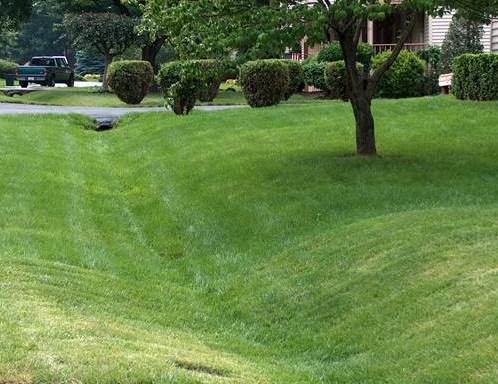 A wide, shallow channel designed to convey water safely. It has gently sloping sides. The swale can be lined with grass or stone to prevent erosion. Swales can trap sediment and pollutants if the water is flowing slowly.
A wide, shallow channel designed to convey water safely. It has gently sloping sides. The swale can be lined with grass or stone to prevent erosion. Swales can trap sediment and pollutants if the water is flowing slowly.
Tamper
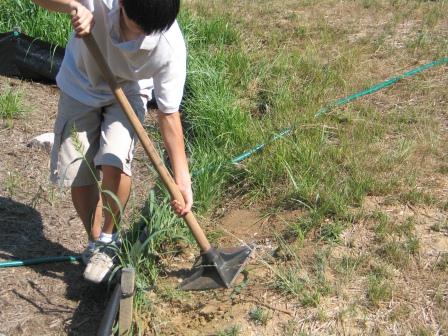 A tamper is a tool used to compact soil. It has a long handle with a flat metal plate at the end. To compact soil, the back of a shovel may also be used.
A tamper is a tool used to compact soil. It has a long handle with a flat metal plate at the end. To compact soil, the back of a shovel may also be used.
Underdrain
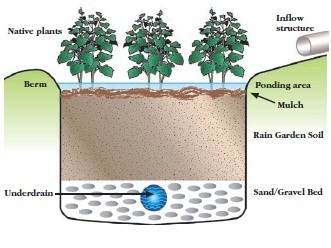 An underdrain refers to an underground drain pipe used with rain gardens or dry wells to allow excess stormwater to be carried away during heavy storms. An underdrain is often necessary in soil with very low permeability. Click on image to enlarge.
An underdrain refers to an underground drain pipe used with rain gardens or dry wells to allow excess stormwater to be carried away during heavy storms. An underdrain is often necessary in soil with very low permeability. Click on image to enlarge.
Underground Drainage System
This is a less preferred option for handling widespread wet conditions. An underground drainage system is a series of perforated pipes buried underground to capture flow from high groundwater. It is similar to a French drain, but at a deeper level. The pipes are installed with a very slight grade. Groundwater enters the pipes and flows to a suitable outlet. This is sometimes referred to as drainage tiles, especially in agricultural settings.
Wetland
 A wetland that meets the Army Corps of Engineers definition is a jurisdictional wetland and is protected under the Clean Water Act. Any disturbance of a jurisdictional wetland in Virginia is prohibited without a permit from the Army Corps of Engineers Norfolk Office or the Virginia Department of Environmental Quality. Some wetlands in Fairfax County are within Resource Protection Areas protected under the Chesapeake Bay Preservation Ordinance.
A wetland that meets the Army Corps of Engineers definition is a jurisdictional wetland and is protected under the Clean Water Act. Any disturbance of a jurisdictional wetland in Virginia is prohibited without a permit from the Army Corps of Engineers Norfolk Office or the Virginia Department of Environmental Quality. Some wetlands in Fairfax County are within Resource Protection Areas protected under the Chesapeake Bay Preservation Ordinance.
Window Well
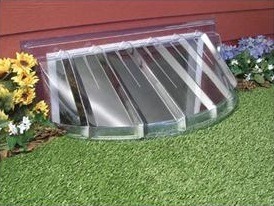 Basement windows are typically situated in a metal-lined, half-cylinder hole that allows light to enter, called a window well. Window wells should be covered with a clear plastic shell to prevent rain from entering the well. Sediments on window wells or outside walls could be an indicator of overflowing gutters.
Basement windows are typically situated in a metal-lined, half-cylinder hole that allows light to enter, called a window well. Window wells should be covered with a clear plastic shell to prevent rain from entering the well. Sediments on window wells or outside walls could be an indicator of overflowing gutters.

